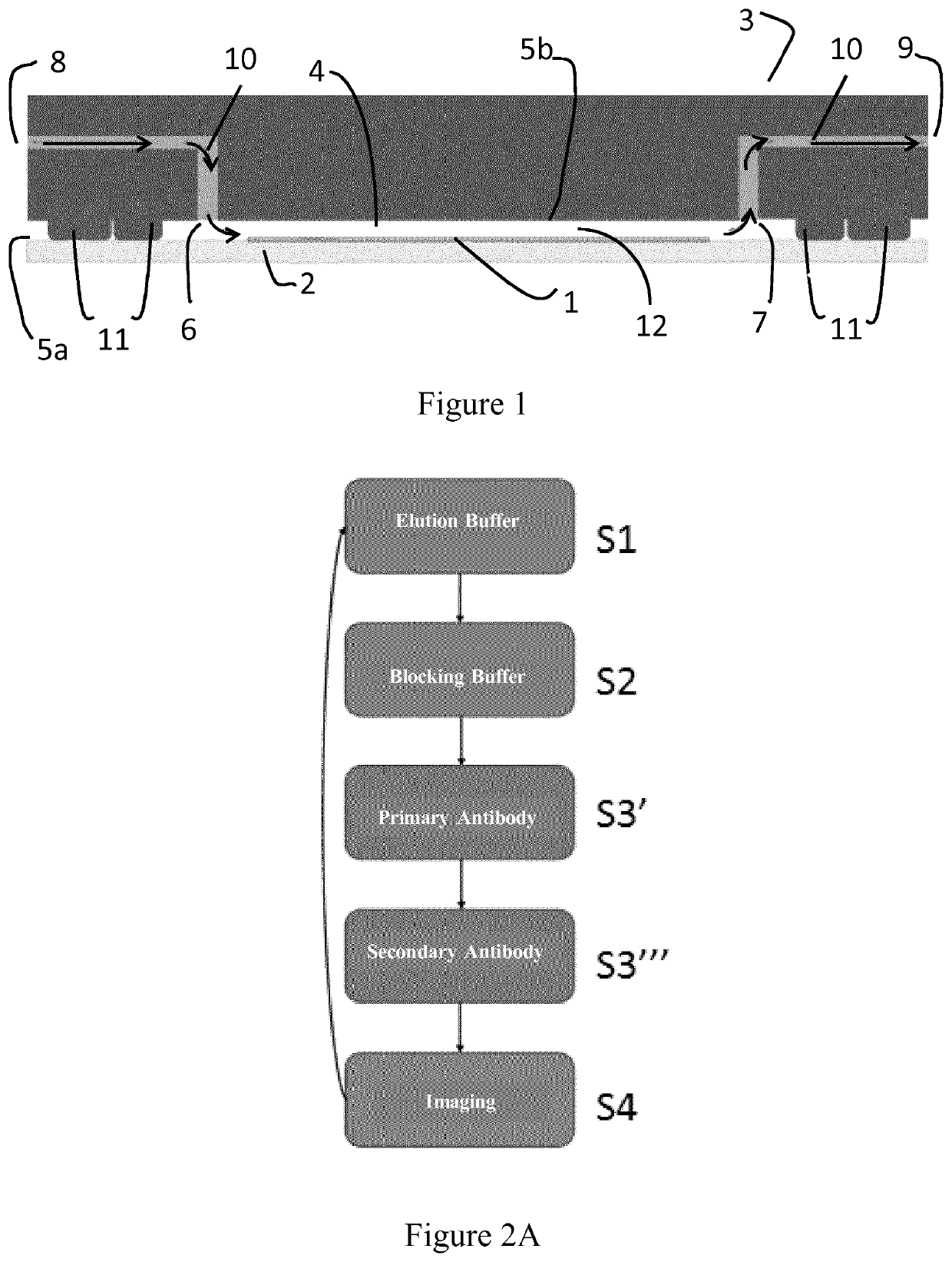Methods of sample cycle multiplexing and in situ imaging
a sample cycle and multiplexing technology, applied in the field of in situ imaging of samples, can solve the problems of inability to accurately and accurately detect the essential spatial details of the sample, limited image-based sample analytical measurement techniques, and inability to accurately and accurately detect the sample, etc., to achieve efficient, accurate and reliable results
- Summary
- Abstract
- Description
- Claims
- Application Information
AI Technical Summary
Benefits of technology
Problems solved by technology
Method used
Image
Examples
example 1
f Multiplexing Protocol to Carry Out Successive Sample Labelling Cycles
[0107]A method of the invention for in situ imaging of samples by cycle multiplexing is implemented in a device on a formalin-fixed paraffin-embedded (FFPE) tissue sample as illustrated on FIG. 1.
[0108]a) Example of Sample Preparation
[0109]Different types of sample preparation steps can be realized depending on the sample type and desired application. In the present example, the sample preparation steps for FFPE tissue samples which were carried out before multi-staining processes is described here as a typical example.
[0110]The biological samples are first dehydrated at 65° C. for 10 min. After 5 minutes of cool-down, the tissue sections are dewaxed for 10 minutes in a Histoclear solution (e.g. Xylol), followed by rehydration in 100%, 95%, 70% and 40% (vol. / vol.) ethanol, respectively. Finally, the heat-induced antigen-retrieval process is carried out with a sodium citrate buffer (about pH 6) or EDTA buffer (abo...
example 2
f Using an Imaging Buffer of the Invention in a Method of the Invention
[0150]The present example illustrates the use of an imaging buffer according to the invention used to improve the efficiency of fluorescent molecule removal from samples under high intensity light, which is particularly useful in a method according to the invention.
[0151]Formalin fixed HeLa cells were applied to one sample labeling cycle according to the multiplexing protocol as described under Example 1. Then, imaging was performed using either phosphate buffered saline (PBS) alone or in combination with a radical-scavenging agent as imaging buffer. Afterwards, the elution step was performed as described under Example 1 and a second sample labeling cycle was performed, omitting the primary antibody binding step, and a larger imaging area was scanned when compared to the first imaging round, while leaving all other imaging parameters such as laser intensity and exposure time unchanged. In the shown images, the ou...
example 3
ed Colocalized Staining of ER, CK, PR and HER2 on a Breast Tumor Sample
[0155]Formalin-fixed paraffin-embedded (FFPE) tissue slides can be stained while also imaging the sample between each step using the methods disclosed in the present invention. As an illustrative example, an FFPE breast tumor section positive to estrogen receptor (ER), progesterone receptor (PR), cytokeratin (CK) and epidermal growth factor receptor 2 (HER2), has been stained using sequential multiplexing according to a method of the invention using in sequence a plurality of reagents and imaging steps determined according to data derived from preliminary test results. The sample has been first prepared for staining through the dewaxing, rehydration and antigen retrieval processes as described in the previous examples and then subjected to a method of in situ imaging of the invention are summarized in Table 2 below. Each marker has been detected in the imaging step using sandwich assays with fluorescent detection...
PUM
| Property | Measurement | Unit |
|---|---|---|
| volume | aaaaa | aaaaa |
| volume | aaaaa | aaaaa |
| flow rate | aaaaa | aaaaa |
Abstract
Description
Claims
Application Information
 Login to View More
Login to View More - R&D
- Intellectual Property
- Life Sciences
- Materials
- Tech Scout
- Unparalleled Data Quality
- Higher Quality Content
- 60% Fewer Hallucinations
Browse by: Latest US Patents, China's latest patents, Technical Efficacy Thesaurus, Application Domain, Technology Topic, Popular Technical Reports.
© 2025 PatSnap. All rights reserved.Legal|Privacy policy|Modern Slavery Act Transparency Statement|Sitemap|About US| Contact US: help@patsnap.com



